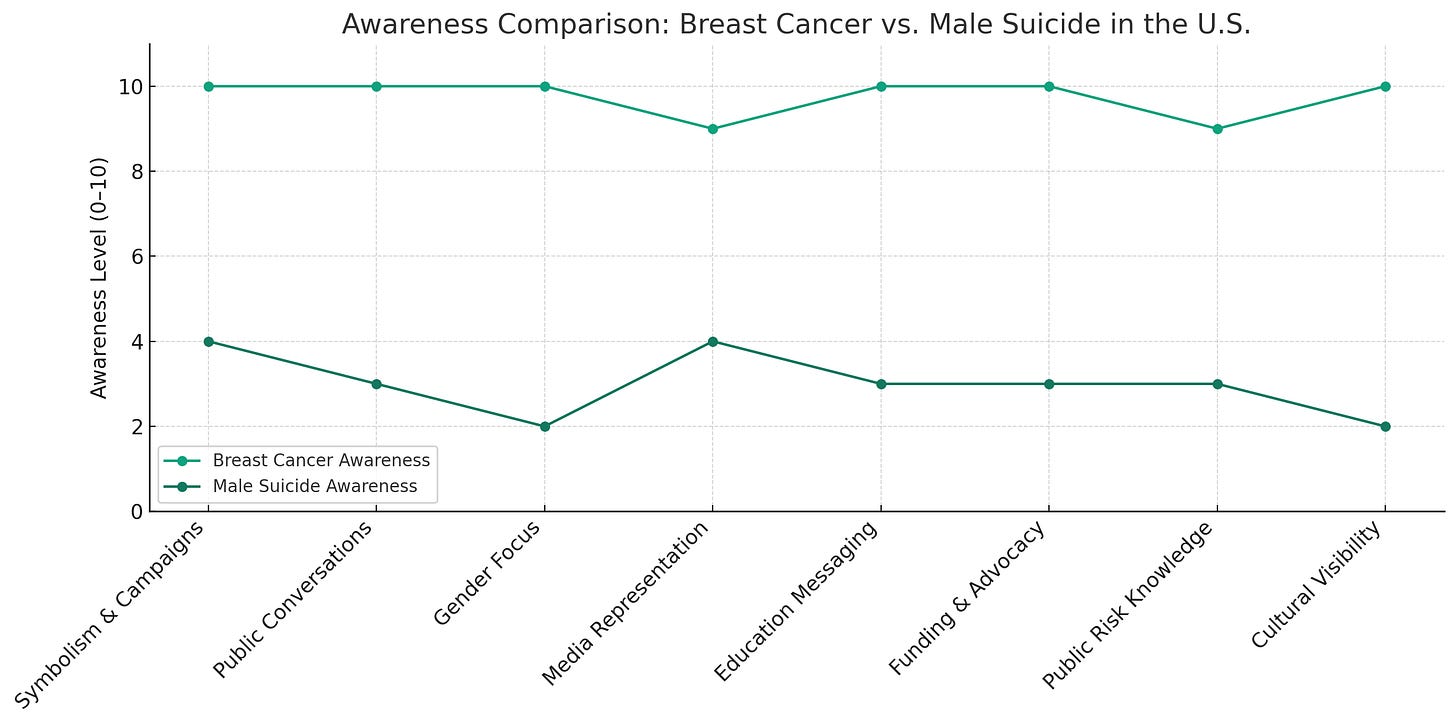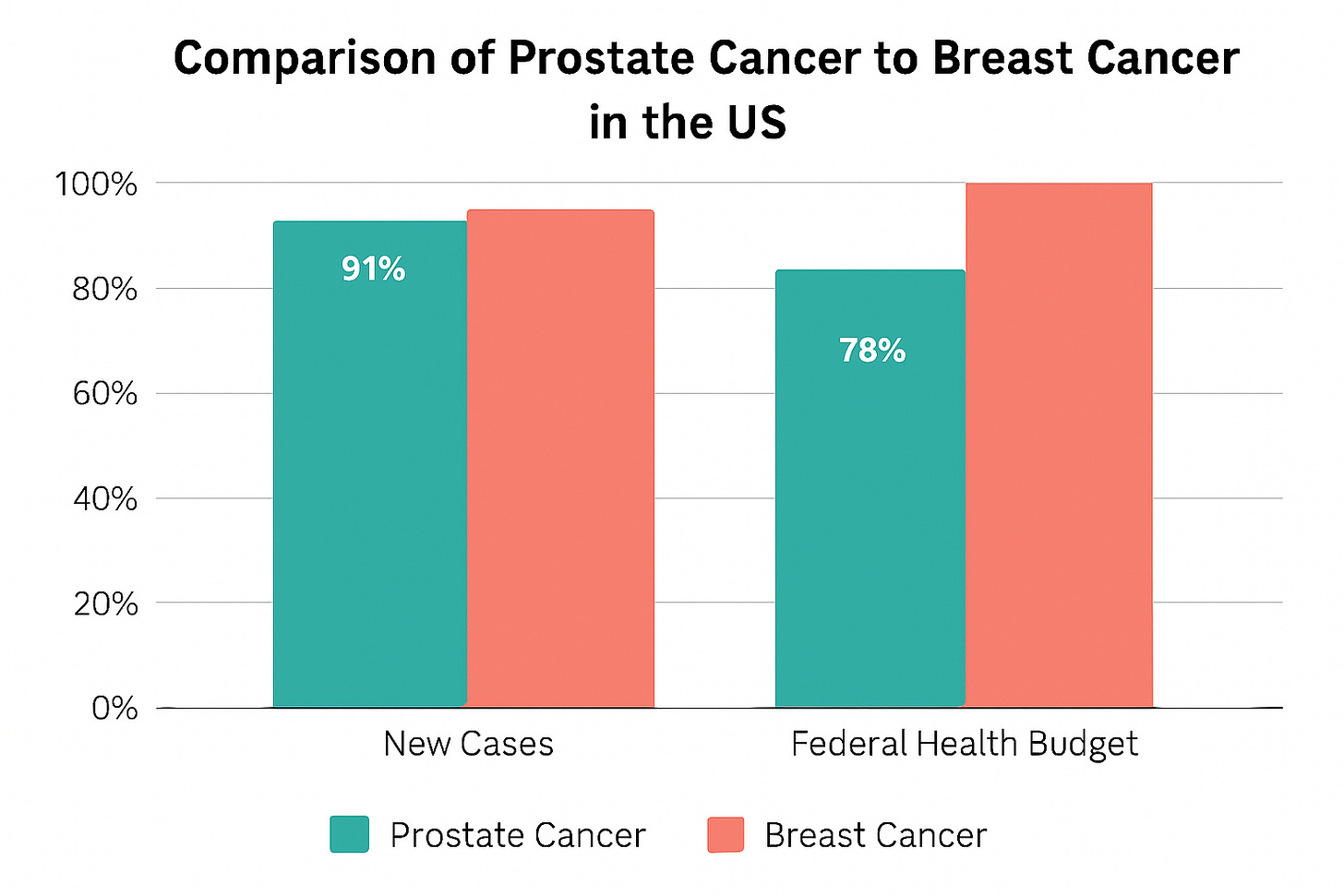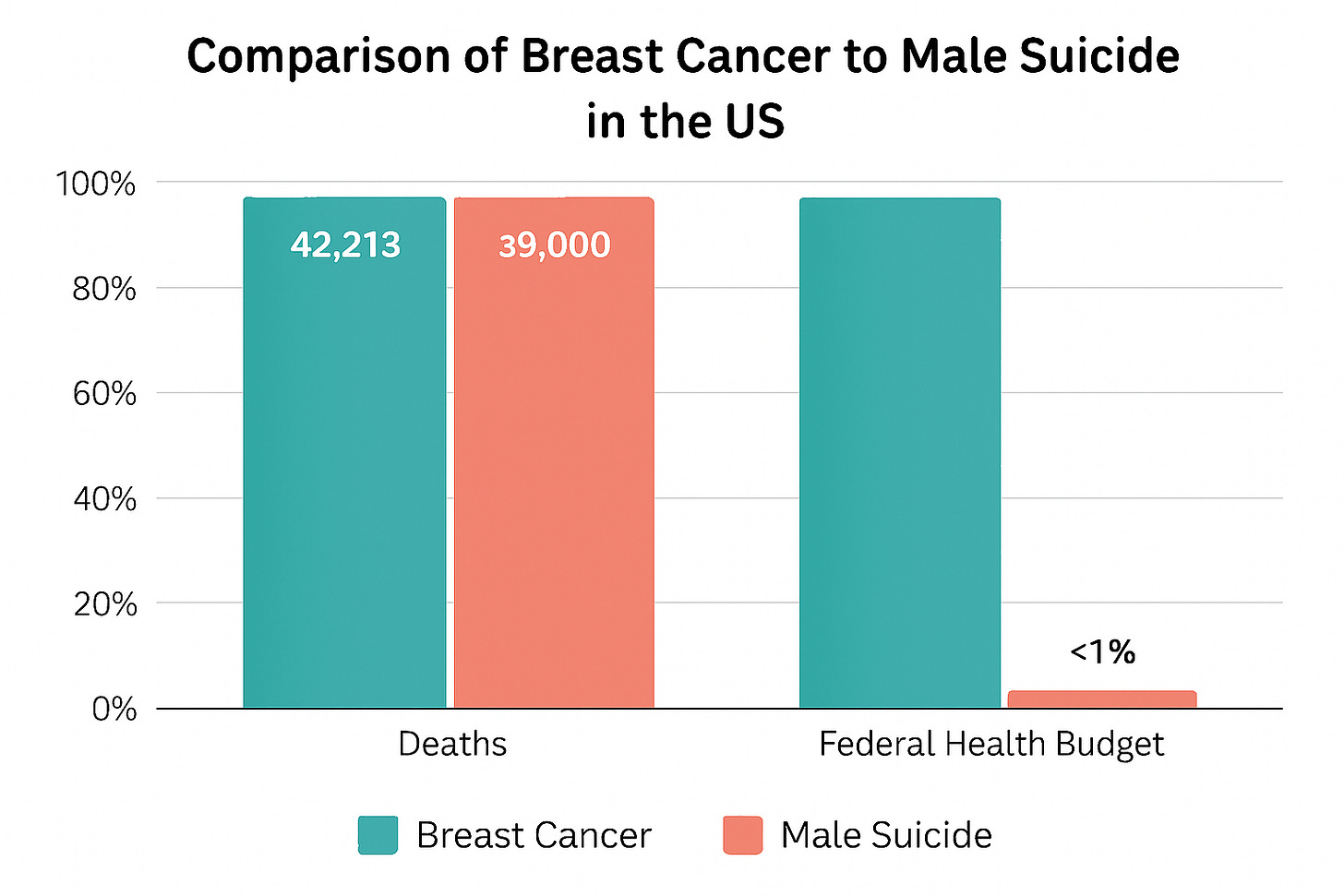The Inequality We’re Not Allowed to Acknowledge
Some may notice that I’ll write about children, parenting, biblical issues, church issues, relationships, and some current events. But you may notice that I tend to lean towards and often revisit issues of men’s health. It’s not that men are more important than women, couples, and children. They’re not. It’s not that men are smarter or dumber than women. IQ levels have remained rather steadily similar across cultures and time. It’s because while the whole world is willing to talk about the help that women (rightly) need, such as areas of attempted suicide or breast cancer, no one is addressing the growing problems that plague men and boys. The conversation is very one-sided. I’m not asking for the side to switch, just to show both sides.

Awareness and Budget Comparisons
Take a look at breast cancer awareness vs. male suicide awareness:
- Breast Cancer Awareness: Saturated, normalized, well-funded, and embraced by culture (I have two Breast cancer awareness bands on right now)
- Male Suicide Awareness: Underrepresented, stigmatized, and critically lacking in broad public engagement.

Or maybe we can look at how many new cases of breast cancer vs. new cases of prostate cancer there are each year, and the correlating federal health budget for each:
- New cases: Prostate cancer new cases are about 91% of breast cancer new cases (255,395 vs. 279,731).
- Federal health budget: Prostate cancer funding is roughly 78% of breast cancer funding ($319.8M vs. $410.5M).

Or we could look at federal health budgets for breast cancer vs. male suicide. You’ll see that male suicide is 90% of the total deaths from breast cancer. But the budget for male suicide is < 1% of the budget for breast dancer. Dr. Richard Reeves might call that a Gap!

Any way you view it, it’s a problem. And many are rightfully calling it a crisis. Surely those in academia are seeing this and doing their part. Certainly they have an avenue to bring awareness to this issue and are willing to do so… right?
The Chance For Exposure
Ladies and Gents, step right up. I present to you Exhibit A! The reason I write about men and boys’ issues. I have had hope that the Association for Psychological Science (APS) wouldn’t be so ideologically captured. And for the most part, compared to the American Psychological Association (APA), they’re not. It’s rather difficult to be more ideologically captured than the APA. But here, with exhibit A, we see the blatant move to turn their heads and act like the elephant really isn’t so big. “Maybe if we just ignore it and pretend the elephant isn’t there, it will just go away.” Well, I’m sorry to report, it won’t, because of people like me.
The article is titled, “Science Counters Education Inequality.” In this article they cover educational gaps in society. They covered SES gaps, race gaps, and differences in STEM, reading, and math. They noted, “Women remain underrepresented in science, technology, engineering, and math (STEM) fields.” And even while highlighting math, they said, “They’re normally as skilled as boys or even better. The only issue is that they tend to be even better at reading even if they’re good in mathematics.” Every paragraph illuminated ways in which we should close gaps for girls and women. How we should be working towards girls advancing, and the issues that women face. They covered educational inequality—for females.
The Real Inequality
If you’ve read anything I’ve written, you already know where I’m going. They obviously ignored some keys points. They ignored that:
- There is a hiring bias in favor of females in STEM.1
- While there is a small gap in favor of boys in math, boys are an entire grade behind girls in English.2
Which gap is larger, a slight lead, or an entire grade behind?! They saw gaps in education among race, STEM, and SES, but outright refused to acknowledge the largest gap in the U.S. and the world in education, gender.
The gender gap in education is the largest of any other demographic comparison on earth. Boys are significantly behind in many areas. Possibly as a result of:
- Feminized classrooms, calling boys who can’t sit still dysfunctional and in need of a diagnosis. Boys are wired to seek, risk, find adventure, and test boundaries. Sitting still simply isn’t what they are wired to do.
- Maybe it’s because of a teacher bias in favor of females.3
- Perhaps it is society’s paradoxical nature, condemning what it quietly perpetuates, insisting that boys suppress their struggles, “Figure it out” and “Get over it”, as if their pain were a nuisance rather than a need.
Regardless of the cause, the reality remains unmistakable: men and boys are in crisis. The evidence is undeniable. Yet when the APS was handed the chance to confront it, they turned their backs like cowards. As if moral responsibility were optional. As if truth itself could be banished by refusing to look at it. But truth doesn’t vanish; it waits, patient and unyielding, exposing the cowardice of those who pretend it’s not there. They had a moment to choose courage over comfort, and they chose comfort. I shouldn’t be surprised by their retreat. But it’s possible the lingering surprise is proof I still expect more from those who claim to seek truth. They didn’t just miss the mark, they threw the target in the trash. If Dr. Richard V Reeves were there, he’d be white-knuckled and asking what on earth they were thinking. Scratch that, he wouldn’t have to ask. We both know they saw the opportunity, recognized it for exactly what it was, and still, intentionally decided to parade out Exhibit A in willful blindness.
I guess they believe if they just go ostrich-style, we will just shut up. Well, they severely underestimated my stubbornness.
Stay Classy GP!
Grainger
References
1 Honeycutt, N., Careem, A., Lewis, N. A., Jr., & Jussim, L. (2020, August 18). Are STEM Faculty Biased Against Female Applicants? A Robust Replication and Extension of Moss-Racusin and Colleagues (2012). https://doi.org/10.31234/osf.io/ezp6d
2 Reardon, S. F., Fahle, E. M., Kalogrides, D., Podolsky, A., & Zárate, R. C. (2019). Gender achievement gaps in U.S. school districts. American Educational Research Journal, 56(6), 2474–2508. https://doi.org/10.3102/0002831219843824
3 Terrier, C., & Terrier, C. (2020). Boys lag behind: How teachers’ gender biases affect student achievement. Economics of Education Review, 77, 101981. https://doi.org/10.1016/j.econedurev.2020.101981

